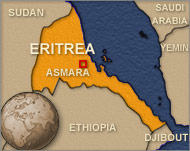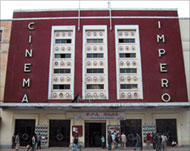Eritrea struggles to save heritage
Home to a surprising wealth of ancient and art deco architectural treasures – many now threatened – impoverished Eritrea is seeking urgent help to preserve disintegrating historic sites.

Years of neglect, decay, war and now pressure from modern development have imperilled a unique trove of largely overlooked and now highly endangered gems, including one of the world’s highest concentrations of early modern architecture.
With three out of the planet’s 100 most endangered sites listed by the World Monuments Fund (WMF), Eritrea has more threatened areas than any other country in sub-Saharan Africa and is on a par with Egypt for the entire continent.
Alarmed by the findings, contained in a report issued by the New York-based WMF in June, Eritrean authorities are now fighting time and funding shortages to restore and preserve the nation’s heritage.
“Our aim is to rehabilitate all the cultural assets in Eritrea,” said Gabriel Tzeggai of Eritrea’s Cultural Assets Rehabilitation Project (Carp), which has been mandated to oversee restoration projects on the three WMF-identified sites.
“Rehabilitation requires you to be very careful,” he said.
“It will take time. We don’t only need funds but also technical assistance. We need guidelines and a management plan.”
Fusion
 |
|
Eritrea has the most threatened |
The work will be the first of its kind in the Horn of Africa nation, which won independence from Ethiopia just 12 years ago and faces myriad social and economic pressures that are perhaps more pressing than architectural restoration.
|
|
“This report will be helpful for us,” Gabriel said, referring to the WMF’s placement of Eritrean sites on its “most endangered” list.
“I hope it will attract new funds because Eritrea is a poor country and so far it has had other priorities than its heritage,” he said.
According to the WMF, Eritrea’s capital, Asmara, boasts one of the world’s highest concentrations of early modern architecture built during the occupation of Abyssinia by fascist Italy between 1936 and 1941.
“The urban fabric of Asmara’s city centre represents a bold attempt to create a utopian city based on modernist planning and architectural ideals,” it said.
“The fusion of European modernism with African highland culture resulted in a unique urban environment that has survived remarkably intact.”
Varied styles
 |
|
Buildings represent such styles as |
More than 400 buildings – representing such varied styles as Novecento, Neo-classicism, Neo-Baroque, Futurism and Rationalism – remain from that period, but almost all are now in danger from development and decay, the WMF said.
At the same time, similar threats exist in the Red Sea port of Massawa, where numerous fortifications and a governor’s palace dating from the Ottoman Empire as well as a 16th-century mosque are facing similar pressures, it said.
“Since [1991], little has been done to restore the city’s historic buildings,” the WMF said, noting damage done by bombings during the Eritrean independence struggle.
“Structures that have survived … are now in danger of collapse,” it said. “Others have been razed to make way for new development.”
Funding limited
Gabriel acknowledged the problems.
|
“The fusion of European modernism with African highland culture resulted in a unique urban environment that has survived remarkably intact” Gabriel Tzeggai, |
“Construction of new buildings in Asmara and Massawa has sometimes negatively affected the existing heritage,” he said.
“We have to be very careful.
“It is important for the nation that there is a push for development for new housing, for new tourism facilities, but we also have to preserve our heritage.”
Eritrea’s third most endangered historical site, the medieval Orthodox Kidane-Mehret church in the south, is the most imperilled, having lost its roof nearly a decade ago.
“Surviving roof beams are rotting, paintings on interior pillars are deteriorating and the building’s structural integrity has been compromised,” the WMF said.
Year-long emergency repair work is estimated to cost at least $100,000 for which funding is severely limited, according to Gabriel, who said the WMF report had thus far sparked donations of $9000.